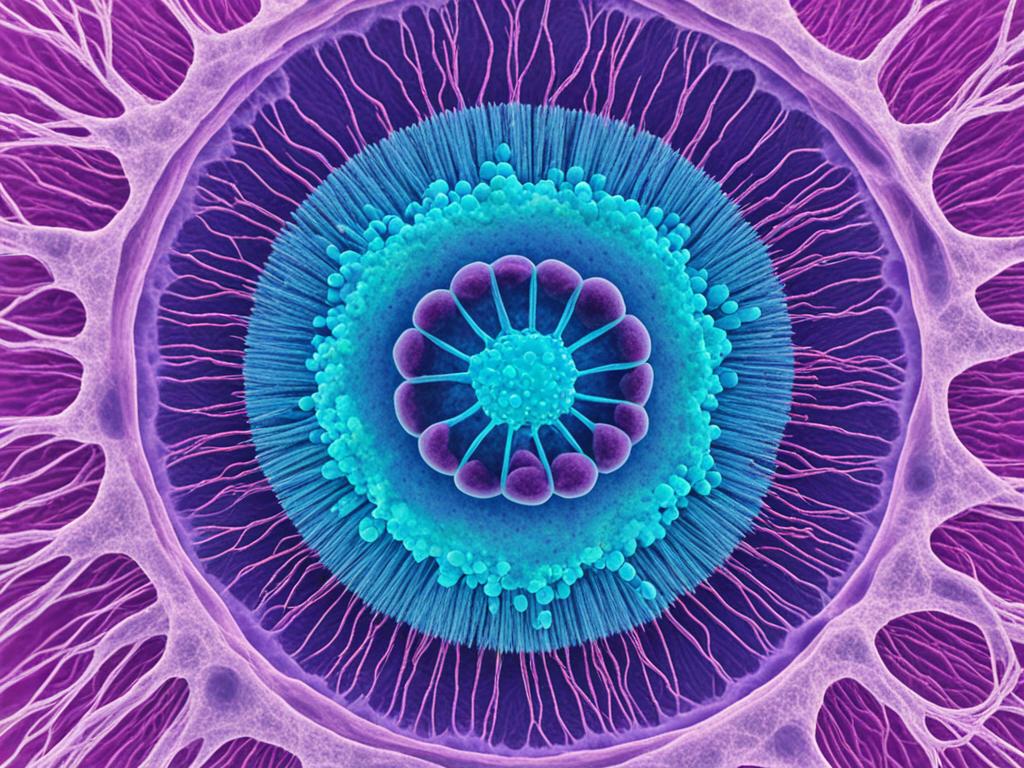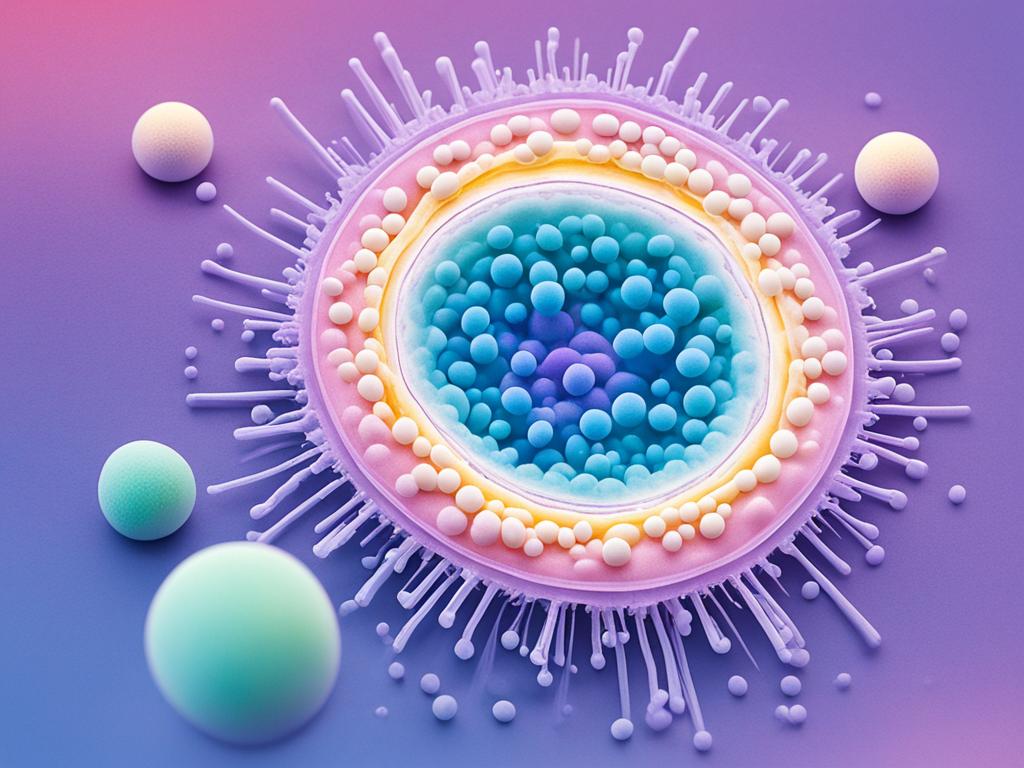The nucleus plays a key role in managing most cell activities. It marks the difference between prokaryotic and eukaryotic cells. The nucleus is a core part of eukaryotic cells, enclosed by a double membrane. Inside, it holds the cell’s DNA.
The nucleus stores the cell’s genetic information. This info is in the form of DNA molecules wrapped around proteins, called chromosomes. The genes in these chromosomes tell the cell what proteins and enzymes to make. These are key for the cell’s structure and working. The nucleus keeps these genes safe and controls how the cell works by managing gene expression.
Key Takeaways
- The nucleus is a key part of eukaryotic cells, found in many organisms, from plants to animals.
- A nuclear envelope wraps the nucleus to keep its contents separate from the rest of the cell.
- The nuclear matrix supports and organizes the nucleus’s genetic material, helping control the cell by managing gene expression.
- Chromatin holds the cell’s activity instructions in its DNA and proteins.
- By governing gene expression and safeguarding the cell’s genetic material, the nucleus manages the cell’s functions.
The Nucleus: Definition and Importance
The nucleus is a key part of eukaryotic cells, setting them apart from prokaryotic cells. It keeps the cell’s genetic info and acts as its control room. Tasks like copying DNA, making RNA, and some DNA tasks happen there.
Eukaryotic Cells vs. Prokaryotic Cells
In eukaryotic cells, the nucleus is a special place with a border where the cell’s DNA lives. But in prokaryotic cells, there’s no barrier around the DNA. So, eukaryotic cells have a real nucleus, while prokaryotic cells don’t.
Repository of Genetic Information
The nucleus keeps the DNA apart from the rest of the cell. This helps control how genes are used and makes sure DNA copies correctly when cells divide. Because eukaryotic cells have this feature, they can do more and have different parts than prokaryotic cells.
| Characteristic | Eukaryotic Cells | Prokaryotic Cells |
|---|---|---|
| Nucleus | Have a membrane-bound nucleus | Lack a membrane-bound nucleus |
| Genetic Material | DNA is organized into chromosomes within the nucleus | DNA is not enclosed within a nuclear membrane |
| Complexity | Highly complex with membrane-bound organelles | Relatively simple, without membrane-bound organelles |
| Reproduction | Divide through mitosis | Divide through binary fission |
Roles of the Nucleus
The nucleus is like the control room for eukaryotic cells. It manages the cell’s activities. DNA replication happens here, where genetic material is copied for growth and division.
Enzymes like helicase and DNA polymerase help in this important task.
DNA Replication
DNA replication is how cells make copies of themselves. It’s a semiconservative process, meaning each new DNA has one old and one new part. This makes sure genetic info is passed down right.
Even with checks, mistakes during replication can happen. Mechanisms like DNA proofreading fix these errors.
Transcription and RNA Processing
In the nucleus, transcription turns DNA into RNA. RNA processing also happens here. These steps are key in sending instructions within the cell.
Regulation of Gene Expression
The nucleus controls when and how genes work. It plays a big role in creating proteins or RNA. The nuclear envelope helps by separating genome and cell fluid.
This allows unique gene regulation methods in eukaryotic cells.
This includes controlling when genes are turned on or off. The nucleus is crucial for managing a cell’s life cycle.

The Nucleus: Control Center of the Cell
The nucleus is like the control center of a cell. It’s in charge of nearly all the cell’s activities. With its genetic material, the nucleus decides what proteins and enzymes to make. Then, these helpers take care of the cell’s work.
It plays a big role in holding and managing the cell’s genetic code. Because of this, it’s known as the control center of the cell. All the instructions for making proteins are kept here. It also does the important job of DNA replication. This is needed for the cell to grow and divide.
Cells can be different, especially their nuclei. For example, some cells, like muscle cells, have more than one nucleus. But, red blood cells don’t have any. They get rid of their nuclei to fit more hemoglobin, which helps carry oxygen.
The nucleus is really important because it keeps the cell’s genetic info and controls what the cell does. It’s like a library and an office all rolled into one.
The Nuclear Envelope
The nuclear envelope is key in eukaryotic cells. It makes sure the genome stays separate from the cytoplasm. This double-layered structure forms a barrier around the nucleus. It keeps genetic material safe and controls what moves between the nucleus and the cytoplasm.
Separating the Genome from the Cytoplasm
In eukaryotic cells, keeping genetic material and protein-making sites apart is important. It lets cells carefully control how proteins are made from the DNA. The nuclear envelope acts as a gate, only letting certain molecules go in or out. This helps the cell do things like read its DNA correctly and make sure proteins are shaped right.
Regulating Molecular Transport
The nuclear envelope does more than just separate the nucleus. It helps regulate what goes in and out. The nuclear pore complex, made of many proteins, controls this movement. It makes sure the nucleus and cytoplasm keep their unique traits and communicates well. This way, the cell can work properly.

Internal Organization of the Nucleus
The nucleus is like the brain of a cell, handling commands. It’s packed with vital stuff – the DNA. This genetic material is neatly set up into chromatin and then into chromosomes. This system is key for gene expression and sharing the DNA right during cell splits.
Chromatin and Chromosomes
The chromatin links DNA with histones, forming a neat, space-saving bundle inside the nucleus. These bundles turn into chromosomes, the DNA-packed units of life’s info. It makes sure genes work as they should and that the DNA splits correctly.
In humans, there are about 46 of these chromosomes with a ton of genes inside. This setup lets our cells finely tune how these 22,000 genes are used.
| Cellular Characteristic | Description |
|---|---|
| Nuclei in Muscle Cells | Muscle cells can often be multinucleated, containing more than one nucleus. |
| Mammalian Red Blood Cells | Mammalian red blood cells (RBCs) do not contain nuclei. |
| Human Genes and Chromosomes | Humans are estimated to have almost 22,000 genes distributed on 46 chromosomes. |
| Cell Production in Humans | Billions of new cells are produced in an adult human every day. |
| Non-Dividing Cell Types | Some cell types, like nerve cells, skeletal muscle fibers, and cardiac muscle cells, do not divide. |
| Rapidly Dividing Cell Types | Epithelial cells of the skin and gastrointestinal lining divide frequently to replace cells rubbed off the surface. |
This detailed nuclear organization keeps our DNA intact and our genes in check. It helps the cell do its job well.
The Nucleolus
The nucleolus is a dense area inside the nucleus. Here, ribosome biogenesis happens. This means ribosomes, which help make proteins, are built here. The nucleolus is where the rRNA for ribosomes is made. It’s put together with ribosomal proteins here too.
Ribosome Biogenesis
The nucleolus is key for making ribosomes, essential for protein making. It’s in charge of turning rRNA from the genes into ribosomal proteins. This is how ribosomes are formed. This process keeps a good amount of ribosomes available. It helps the cell keep making proteins for growth and division.
| Statistic | Value |
|---|---|
| Human genome rDNA repeat units | Approximately 400 copies of 43-kb repeat units distributed along chromosomes 13, 14, 15, 21, and 22 |
| Arrangement of rDNA repeats | One-third are arranged into palindromic or non-canonical repeats, while the rest are mostly arranged into head-to-tail repeats |
| Size of rDNA repeat | 43 kb, including a 13-14 kb segment coding for rRNA sequences and 30 kb intergenic spacers with regulatory elements |
| Chromatin state of active vs. inactive rDNA | Active regions lack nucleosomes, while inactive rDNA exhibits regularly spaced nucleosomes |
There are about 400 43-kb repeat units in the human genome. They’re found on certain chromosomes and are called Nucleolar Organizer Regions (NORs). The organization of these repeat units is complex. Some are arranged as palindromes or in other unusual ways. The rest are often arranged head-to-tail. Each 43 kb repeat unit has parts that code for rRNA and others with spacer DNA. This spacer DNA includes important gene parts. The state of these regions’ nucleosomes shows if the DNA is active or inactive.
The Cell Cycle and Mitosis
The nucleus is key in the cell cycle and mitosis, which is cell division. When cells divide, their genetic material must split and move into the new cells carefully. This requires the condensation of the chromosomes and breakdown of the nuclear envelope. This lets the chromosomes move into the new cells.
Chromosome Condensation
During the cell cycle, DNA strands are turned into chromosomes. This is important for splitting the genetic material evenly. Remember, DNA is very thin in the nucleus. But it condenses into chromosomes for easier handling during mitosis.
Nuclear Envelope Breakdown
For proper chromosome division, the nuclear envelope has to open. This happens at the start of mitosis, in prometaphase. The open nuclear envelope lets the chromosomes line up correctly. Then, they can move into the new cells.
Evolutionary Significance of the Nucleus
The nucleus is a key part of eukaryotic cells, setting them apart from prokaryotic cells. It plays a big role in their evolution and complexity. By holding the genetic material apart from the rest of the cell, the nucleus allows for special ways of regulating genes.
Complexity of Eukaryotic Cells
This added complexity fueled the evolution of eukaryotic cells, leading to their diverse functions and organelles. Over time, there has been a 150% increase in certain cell components with similar structures. This growth shows how important the nucleus has been in the development of these cells (Devos et al., 2004).
The nuclear pore complex is another key part, remaining 80% similar across eukaryotic cells’ ancestors. This shows its significance in their evolution. More amazingly, these pores have become 56% more complex than before, adapting to new challenges over time (Alberts et al., 2007; Field et al., 2014).
The nucleus has been a crucial part of eukaryotic cells’ increasing complexity. It allows for unique gene regulation and control of molecule movement. These abilities have driven the creation of various cell functions and structures not seen in simpler cells.
Source Links
- https://www.alliedacademies.org/articles/nucleus-the-control-center-of-the-cell.pdf
- https://en.wikipedia.org/wiki/Cell_nucleus
- https://med.libretexts.org/Bookshelves/Anatomy_and_Physiology/Anatomy_and_Physiology_1e_(OpenStax)/Unit_1:_Levels_of_Organization/03:_The_Cellular_Level_of_Organization/3.03:_The_Nucleus_and_DNA_Replication
- https://courses.lumenlearning.com/suny-ap1/chapter/the-nucleus-and-dna-replication/
- https://www.ncbi.nlm.nih.gov/books/NBK9927/
- https://www.ncbi.nlm.nih.gov/books/NBK9915/
- https://www.ncbi.nlm.nih.gov/pmc/articles/PMC7123373/
- https://rwu.pressbooks.pub/bio103/chapter/the-cell-cycle-and-mitosis/
- https://bio.libretexts.org/Courses/Cosumnes_River_College/Contemporary_Biology_(Aptekar)/05:_Cell_Division_and_Reproduction/5.02:_The_Cell_Cycle_and_Mitosis
- https://le.ac.uk/vgec/topics/cell-cycle/the-cell-cycle-higher-education
- https://www.ncbi.nlm.nih.gov/pmc/articles/PMC4071446/


